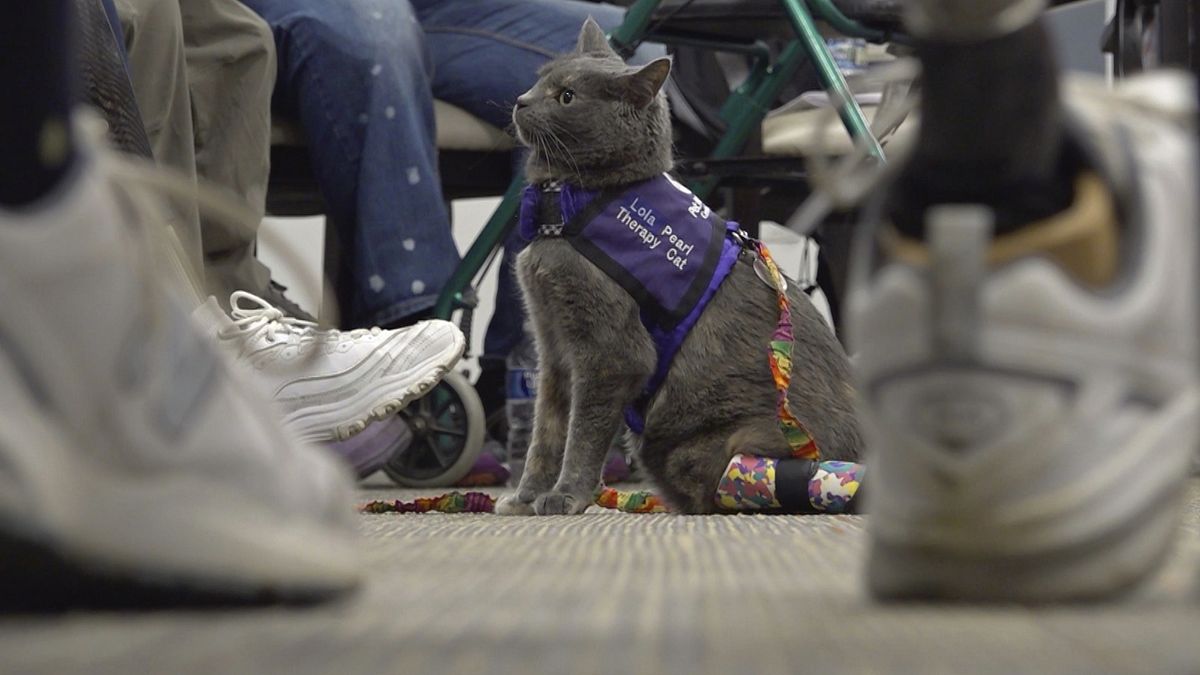There’s abundant research on other therapy animals like dogs but there’s often a ‘shock factor’ involved with therapy cats because many don’t know they exist.
Each morning, Juanita Mengel removes the silicone liner of her prosthetic leg from under a heated blanket so that the metal parts of the artificial limb don't feel as cold on her skin when she straps the pieces together.
The 67-year-old Ohio resident then does the same for her five-year-old dilute tortoiseshell cat, Lola-Pearl, who is missing her left hind leg.
The duo is one of an estimated 200 therapy cat teams registered in the US through Pet Partners.
The nonprofit sets up owners and their pets as volunteer teams who provide animal-assisted therapy such as visiting hospitals, nursing homes or schools.
What is pet therapy?
Pet or animal therapy is a kind of therapeutic intervention that incorporates specially selected and trained animals.
“A therapy animal is an animal who’s been assessed based on their ability to meet new people and not just tolerate the interaction, but actively enjoy it,” says Taylor Chastain Griffin, the national director of animal-assisted interventions advancement at Pet Partners.
The organisation registers nine different species as therapy animals: dogs, cats, horses, rabbits, guinea pigs, rats, birds, mini pigs, llamas and alpacas.
As part of her research, Chastain Griffin studies the impact of therapy cats and argues more research needs to be done.
There’s abundant research on other therapy animals like dogs, she says, but there’s often a “shock factor” involved with therapy cats because many don’t know they exist.
“They go into a setting and people are like, ‘Whoa, there’s a cat on a leash. What’s happening?’” says Chastain Griffin.
“It kind of inspires people to connect in a way we haven’t traditionally heard talked about in other therapy animal interventions.”
A cat-human amputee duo
Owner Mengel says she knew Lola-Pearl would be a good therapy cat after she brought her to an amputee coalition conference on a whim about a month after she adopted the domestic shorthair.
“She was so good with people I just knew she would be a good therapy cat," says Mengel. “People really were attracted to her, too.”
During a recent visit to a limb loss support group meeting, Mengel pushed Lola-Pearl around in a stroller - labelled ‘Therapy Cat’ - so attendees could pet the kitty as she woke up from a nap.
Whether she was sitting in the stroller, walking in between participants' legs or cuddling on their laps, Lola-Pearl brought a smile to whoever she decided was worthy of her attention at that moment.
“She's very intuitive of people,” says Mengel.
Lola-Pearl isn't the only cat in Mengel's life; the former travelling nurse who lost her left leg in 2006 after years of surgeries following a near-fatal car accident is a mother to seven felines, most of which have disabilities.
“They find you, you don't find them,” she says.
Lola-Pearl was found at only a few weeks old with her back legs completely twisted together, unable to walk.
She was brought to specialists in Iowa who were able to splint her legs in an attempt to save them, but they then decided her left hind leg needed to be amputated.
Meanwhile, Mengel had been in talks about adopting the cat, and after Lola-Pearl healed from surgery, Mengel officially adopted her.
After the obstacles Mengel has been through, she is deeply appreciative of Lola-Pearl and for the work they do together.
“It’s a really rewarding experience,” she says. "I get just as much out of it as the people that I visit.”



